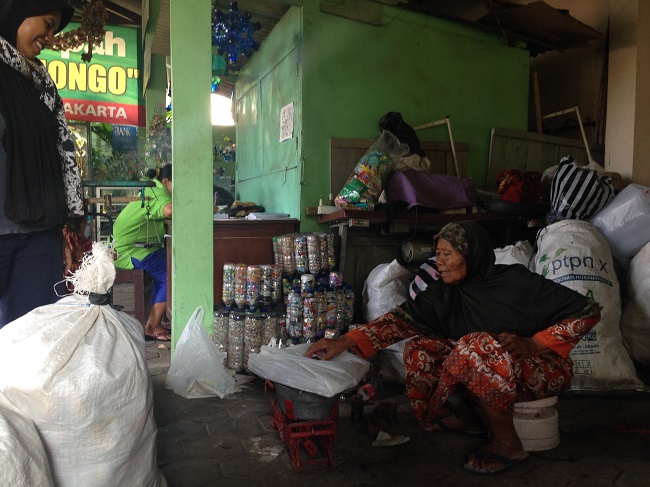Nuzuli Ziadatun Ni’mah and Lena Keller-Bischoff
Waste banks are a novel concept for addressing Indonesian waste problems. Instead of burning their waste or throwing it into rivers, communities establish a place for villagers to deposit their waste. The waste bank, or bank sampah, concept grew from local household initiatives in 2008. In theory, waste banks operate like conventional banks with the exception that, as Nilan and Wibawanto write, people do not save money but, rather, the monetary value of their waste. According to Bambang Suwerda, founder of the waste bank movement, the original concept is that deposited waste is sold to waste entrepreneurs, or pengepul, who then resell it to recycling companies. The Indonesian government endorsed the waste bank concept as ‘currently the best way of dealing with waste across the country’. Suwerda believes that more than 5000 waste banks exist across Indonesia, with the amount of waste processed varying significantly from bank to bank.
To understand the roles played by waste banks, we juxtaposed two field sites: a community run waste bank called Garduaction in a rural area close to Parangtritis (a hotspot for local tourists on the south coast of Java) and the waste bank Lintas Winongo in the centre of Yogyakarta, operated by the local community and supported by Unilever. Both are grassroots waste banks initiated as a reaction to local waste overflow problems and conflict between local environmental departments. How do these waste banks work and how do they respond to critical discourses of waste reduction? What support structures and tensions emerge from their existence? People involved in waste banks often face difficulties in daily life but we found that creativity and strong grassroots agency helped improved the lives of many. Zooming out, local and global power asymmetries play out as waste banks search for funding and community support.
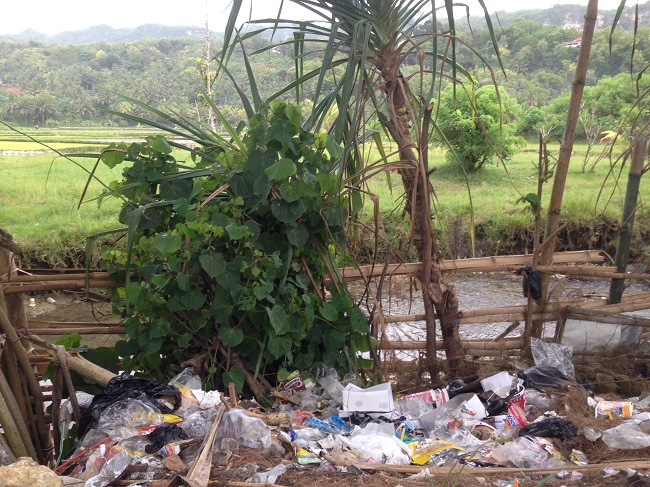
Daily waste practices
At Lintas Winongo, deposits take place on Sunday mornings. Waste bank customers, mostly women, line up carrying big bags on their backs tied together with colourful fabric. They bring different sorts of waste, such as paper, glass and several types of plastic, that are already separated. Different types of plastic have different ascribed values: small plastic water cups are the most valuable type and plastic bags the least. Waste bank volunteers weigh the waste, calculate its monetary value and enter the information into the customer’s account book. Afterwards the waste is put in an open storage space until it is sold to waste entrepreneurs.
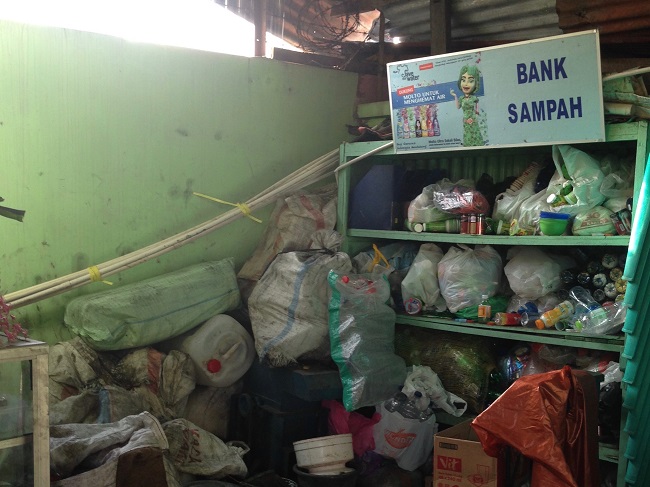
Waste contributors form groups of 10 households in which they rotate turns going to the waste bank. Around 40 customers deposit waste every Sunday, each taking away up to Rp.25,000 (just under A$2.50) per month. The customers tell us that they sometimes demand their savings before the celebration of Idul Fitri or in order to pay for a wedding ceremony, but more often it goes towards communal recreational trips. Schlehe and Yulianto’s research also indicates that social factors are a key motivation for households’ involvement in the waste bank.
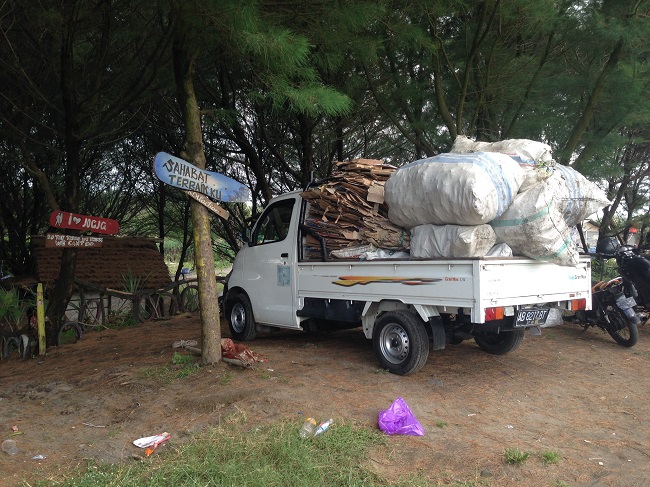
In contrast, at Garduaction the households of the surrounding villages are not active customers at the waste bank. The waste bank organisers believe that the program has not been communicated effectively to local communities and therefore citizens are not aware of the bank’s existence. The system is more complex than what people are used to as several households prefer to sell waste to tukang rongsok (waste pickers who buy waste from households). These tukangs pay them immediately, whereas at Garduaction contributors are only paid every three months.
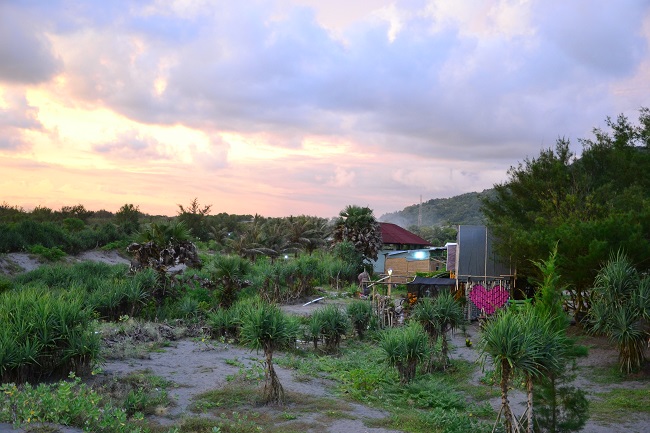
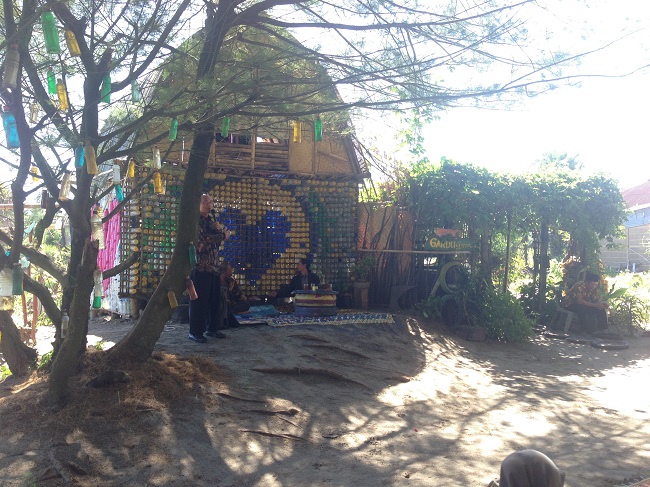
Because the financial incentives are lacking, Garduaction has adapted itself to the local context. When we started our fieldwork, we expected to find a foul-smelling waste bank, unused by the community. Instead, we immediately sensed that Garduaction was a special place. Plastic installations built from painted bottles decorate the entry, leading to an artistic open space featuring handmade, upcycled objects such as chairs made out of car tires and a colourful bamboo hut with plastic walls.
Garduaction’s organisers are not deterred by the waste bank’s lack of finances. Instead, we observed creative grassroots agency: they create and sell plastic installations and offer upcycling workshops to generate income. They also develop unique ways to attract volunteers. Whereas Lintas Winongo pays for the expenses of waste bank volunteers with Unilever funding, Garduaction has no financial means to do so. Instead, the organisers put effort into creating a special place that volunteers can share proudly on social media. They believe that volunteers will enjoy spending time at Garduaction and are more likely to become active volunteers if they have impressive pictures to share on their Instagram accounts.
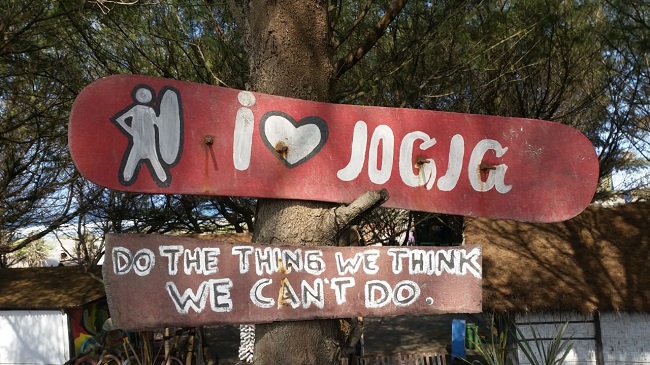
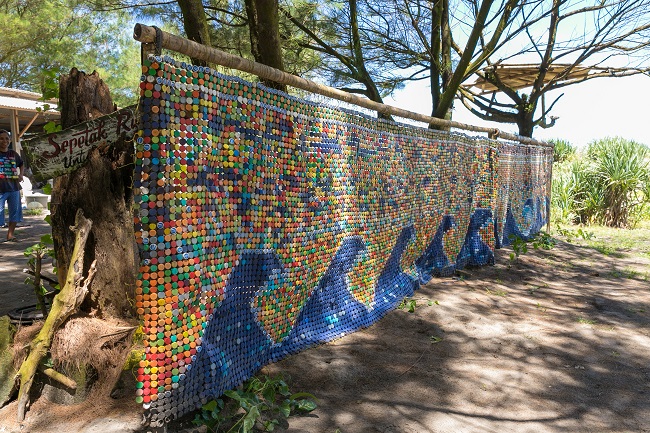
Waste pickers as waste bank customers
The increasing importance of waste as a resource has led to an enormous informal sector that provides income for many people but offers poor and insecure working conditions. In Indonesia, waste pickers are often accused of theft, because – in contrast to tukang rongsok, who are waste pickers that buy waste from households – they collect waste without paying. For this reason, waste pickers occupy a low social position and are marginalised. Lintas Winongo’s organisers explicitly mentioned that they distrust waste pickers and refuse to accept them as customers.
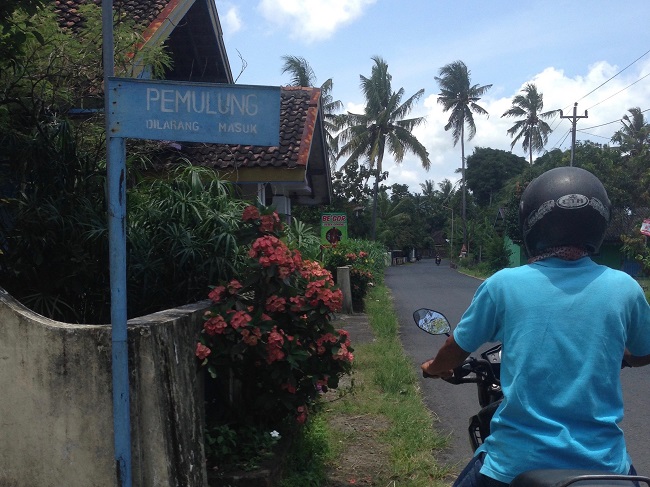
Our findings indicate that waste pickers, who collect waste from streets, open dumpsites or beaches, are active waste bank customers at Garduaction. At Garduaction waste pickers deposit non-separated so-called ‘tourism waste’ which they collect at the beach. For this reason, Garduaction needs to further process the waste and employs waste workers. The workers sit in an open air space next to a stone house where waste is stored. They often separate different sorts of plastic for hours, including, for example, taking plastic labels off plastic bottles. By carefully separating the waste, the economic value of the waste is increased, and it can be sold for higher rates later on.
Waste banks hold low positions in the local waste hierarchy and organisers expressed a wish to cut out the middlemen, in the form of other waste entrepreneurs a rung above them. The fact that small plastic items such as bottle labels get processed is what distinguishes waste banks from waste entrepreneurs – who often burn this type of plastic instead of returning it into the recycling chain, due to its low economic value.
At Lintas Winongo, however, they refuse to accept waste pickers as customers because they are stigmatised and often accused of theft while collecting waste.
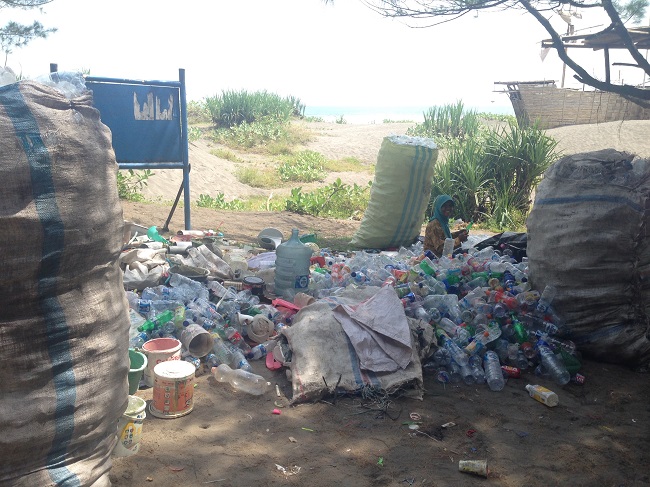
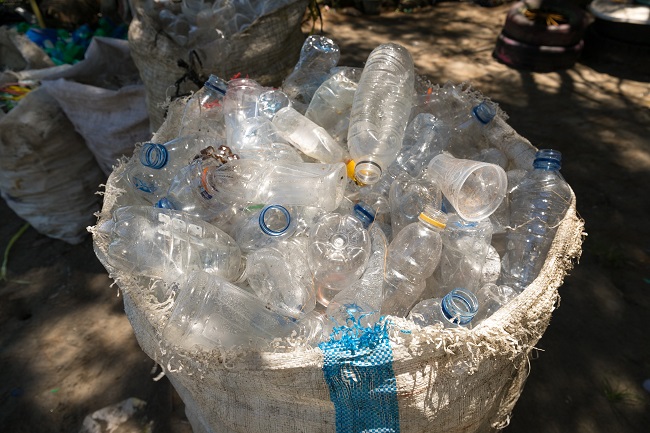
Not just a bank
According to Bambang Suwerda, the waste bank movement strives to change waste pickers’ social status in the long term. In contrast to Lintas Winongo, Garduaction offers social support for and solidarity with people who are excluded from the community due to their socioeconomic background. For example, after losing her previous job, one waste worker had considered working as a tukang rongsok but did not have the financial capital to buy waste from households. She explained that Garduaction enabled her to pay off her debts without requiring starting capital. Various life stories were shared with us illustrating that Garduaction attracts waste pickers and workers who are stigmatised, either due to their profession as waste pickers or due to their ethnic background, disability or injuries, and who were unemployed or homeless (prior to getting into contact with Garduaction). Thus, the waste bank acts as a socially oriented middleman within the local recycling hierarchy.
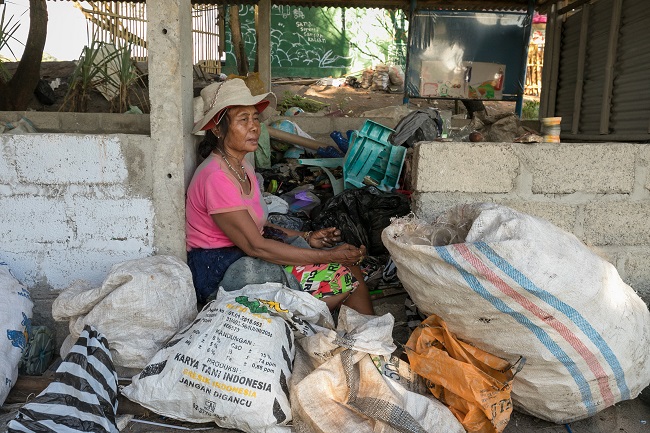
Local and global power asymmetries
At Garduaction we observed inequalities with regard to different people’s exposure to waste. We observed that the more people engaged with dirty waste that has not been separated or processed yet, the more their livelihoods depended on this work. Whereas organisers’ involvement is voluntary and does not involve handling waste, pickers and workers handle dirty waste with their bare hands, and this is their primary source of income. We perceive it as problematic that no working standards are implemented, especially with regard to hygiene and workers’ health.
Many media reports currently repeat the narrative of Southeast Asia being the main plastic polluter. However, Europe collectively is the major exporter of waste and Germany ranks with the world’s top five waste exporters. Since China banned plastic imports in 2018, global waste streams have started to shift to Southeast Asia. We would like to point to the Break Free From Plastic movement whose brand audits indicate that companies headquartered in the global north are the main source of plastic pollution.
Multinationals: polluters and supporters
The Business and Sustainable Development Commission identified waste management as an important trend within the consumer goods industry. The private sector’s interest in waste management projects along its global supply chains is evident in Indonesia. The British-Dutch consumer goods giant Unilever supports waste banks through its corporate social responsibility (CSR) strategy. However, at the same time, Unilever is the eleventh most plastic polluting brand in Indonesia. In cooperation with the local environment department in Yogyakarta, Unilever runs the Green and Clean competition. Waste banks can participate in this annual competition, and the winners (such as Lintas Winongo) receive funding from Unilever, which includes financial and material support as well as mentoring. However, only well-functioning waste banks in cities that process a decent quantity of waste have access to these support mechanisms. Waste banks in rural areas are excluded.
This imbalance reflects international trends since the international development agenda aims at tackling waste problems in urban areas. However, waste does not stick to city boundaries so the focus on urban areas is problematic, especially since it is the incoming tourists that often leave large amounts of waste in rural areas. At the same time, the indicators for a ‘successful’ waste bank are also very narrow, measuring only volume and efficiency. Other aspects, such as the social support or waste-related education projects that we saw at Garduaction, are not taken into account.
According to Bambang Suwerda, producers such as Unilever should take responsibility for the waste generated by their products. However, Unilever policies place the responsibility for waste management back on consumers, drawing on the Javanese socio-cultural concept of gotong royong, or mutual collective help, to support the running of local waste banks. Unilever uses this Javanese concept to legitimise its shifting of responsibility for managing waste on to volunteers at waste banks. Suwerda argues that local communities and volunteers are overworked and need more support. Thus, further engagement, collaboration and support from groups such as local governments and multinational businesses is necessary if waste banks are to have a successful future.
Ironically, Unilever donates goods wrapped in plastic packaging to selected waste banks; some are even packed in small sachets made from flexible multilayer plastics, which are not easily recycled in Indonesia. We came across contradictions between stated priorities (reduction) and priorities on the ground (recycling and upcycling). It has also been argued that certain waste management systems actually incentivise the production of waste. We suggest two different understandings of the term reduction: although we observed no focus on reducing the creation of new waste, our research participants referred to reduction as a way of mitigating environmental pollution by disposing of waste in a less harmful way. While waste banks can play an important role in managing the waste generated within communities, strategies for overall waste reduction have not received widespread support at any stakeholder level.
Nuzuli Ziadatun N'iamh (nuzuliziadatun@gmail.com) studies the Social and Cultural Anthropology master program at Universitas Gadjah Mada (UGM) in Yogyakarta. Together with her tandem partner Lena she conducted six weeks of ethnographic field research in 2018. Her research was supported by the UGM Anthropology Department and she is currently writing her thesis based on the empirical data. Lena Keller-Bischoff (lenakebi@me.com) is a Social and Cultural Anthropologist who studied at Albert Ludwigs University Freiburg, Germany. Her field research was supported by the German Academic Exchange Service (DAAD). As founding member of the interdisciplinary, international collective INDOxMELT she is working on establishing Circular Economy Innovation for Indonesian islands
